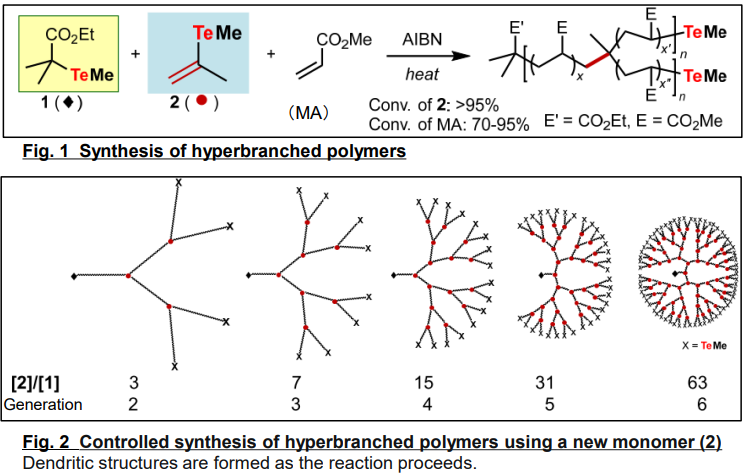Available Technologies
Simple Synthesis of Structurally Controlled Hyperbranched Polymers
One-step method for synthesizing hyperbranched polymers with well-controlled three-dimensional structures.
Background
Hyperbranched polymers with dendritic branching structures are widely used in various applications such as viscosity modifiers, lubricants, catalysts, and drug delivery systems. They have various characteristics that differ from those of the commonly used linear polymers, such as their low resistance, low viscosity, and a large number of polymer ends that can be substituted by various functional groups. However, due to their time consuming synthesis process, three-dimensional structure of the hyperbranched polymers currently used in industry are not very well controlled, varying in their molecular weight, molecular weight dispersity, number of branches, and branching density.
Description and Advantages
To overcome the above problems, researchers at Kyoto University established a simpler and more practical method for synthesizing structurally controlled hyperbranched polymers using organotellurium mediated living radical polymerization (TERP).
➢ Simple synthesis
Dendritic hyperbranched polymers with controlled 3 D structures can be obtained by polymerizing an organotellurium compound (no. 1 in Fig. 1 ) as a controlling agent, a newly designed monomer (no. 2 in Fig. 1 ) and methyl acrylate ( MA ) under living radical polymerization conditions (Fig. 1).
➢ Easy control of branching structure
By changing the amount ratio of the organotellurium controlling agent, new monomer and MA, the molecular weight and the branching structure i. e. number of branches and branching density can easily be controlled while maintaining low dispersity in molecular weight (Fig. 2).
➢ Expanding potential applications of hyperbranched polymers
Since easy control of the branching structure allows systematic changes in hydrodynamic volume and viscosity, hyperbranched polymers can be used as new functional materials, such as medical materials, environment-friendly materials for batteries, catalyst supports, and various additives.

| Development Status |
Developed so far: • New initiators • Method to remove the residual tellurium end • Synthesis method by emulsion polymerization • Method to introduce polar functional groups |
|---|---|
| Offer | • Patent license • Option for patent license • Collaborative Research |
| Related Links | View PDFView in Japanese |
Have you found what you were looking for?
- Interested in a particular research activity
- Cannot find the information
- Have questions on how to utilize research results
Feel free to contact us and get answers to your questions.
Inquiry- TLO-KYOTO
- Available Technologies
- Simple Synthesis of Structurally Controlled Hyperbranched Polymers
3rd Floor, International Science
Innovation Building, Kyoto University
Yoshidahonmachi, Sakyo-ku, Kyoto
606-8501 JAPAN


